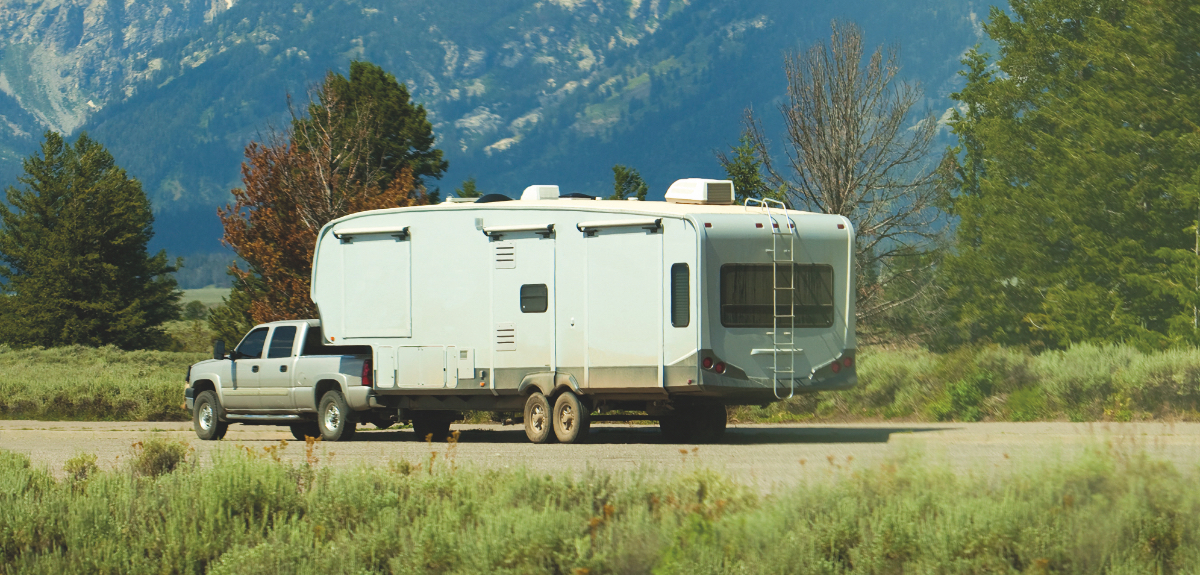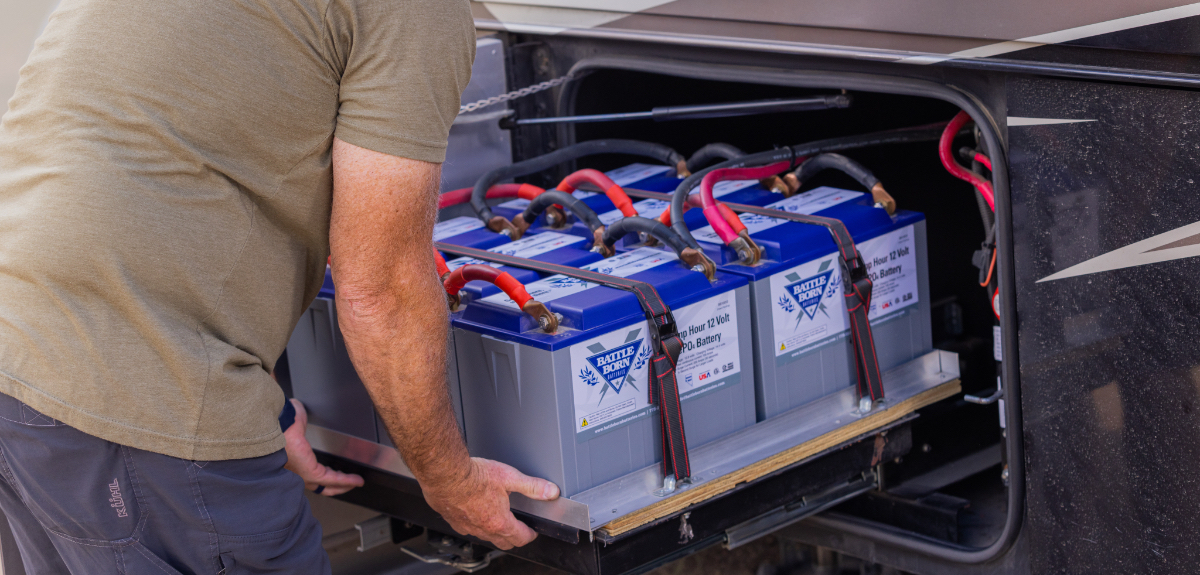Rigs + Gear: EMS for Your RV
Protect Sensitive Electronics When Plugged in at the Campground with a Quality Electrical Management System
Image Caption: Photo Credit: Camco
When I lead seminars about RV electrical systems, one of the most frequent questions I get asked is, “Do you recommend any kind of surge protection for RVs?” And my answer is always an emphatic, “Yes!” But don’t stop at only surge protection … more on that in a moment.
Your rig has a lot of potentially sensitive electronics onboard. The air conditioner, the entertainment system, the battery charger, and anything else you may have plugged in are all at the mercy of that campground power. So it just makes good sense to protect your RV against problems at the pedestal. It’s a reasonable precaution, like putting a water filter or pressure regulator on your incoming water supply.
In our home bases, we’re used to clean, stable power—if there were bad power or wiring issues, we’d already know. At home, we may only use surge protection for our most sensitive electronics. But in an RV, you’re potentially plugging into a different power supply every day, and you typically don’t know a thing about them. Perhaps the campground power system was installed long ago, and it’s not up to modern safety standards. It could have been sized in the era before three-A/C-unit RVs and may have trouble keeping up today. It could have been installed incorrectly by an unlicensed electrician. Any one of these could cause costly or dangerous problems in your RV.
Surge Suppression Versus EMS
One of the first things you’ll notice when you investigate power protection for your RV is that the products can vary a lot in price. This is due to the features and protections built into the various products. On the less expensive end, there are pure surge suppressors. These are essentially just larger versions of the power strips you use in your home. And they’re better than nothing at all.
But at the other end are full-function Electrical Management Systems (EMS). Though they cost more, they can also protect your RV against a greater variety of electrical issues that would get past a pure surge suppressor. Some of these extra protections target very common problems. That’s why I tell people not to stop at simple surge protection.
So, let’s dive into the different problems these devices can protect you from. Then, you should be able to determine what level of protection matches up with your RV lifestyle.
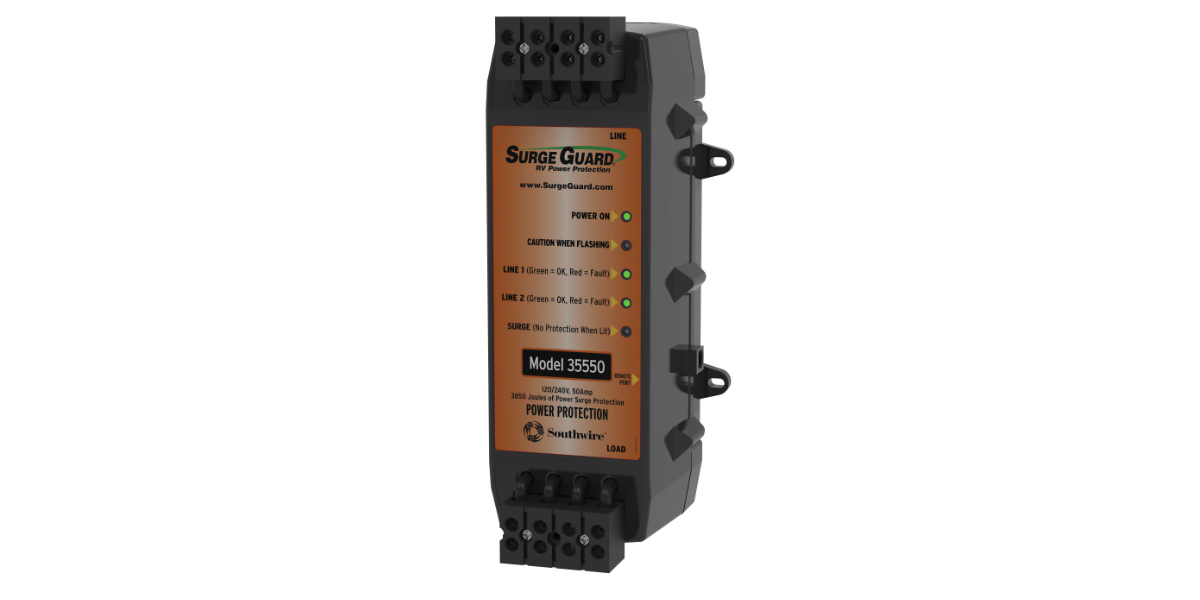
Hardwired units like the Southwire SurgeGuard offer remote informational displays that can be placed in the RV, while the unit itself is hidden away away in a utility space. Photo Credit: Southwire
Power Problems
Surges + Spikes
We’ll start with what everyone probably thinks of first. Surges and spikes are both types of over-voltage conditions, and the difference between them is that a spike may only last a few nanoseconds (billionths of a second), while a surge can last for longer. But regardless of the duration, excessive voltage can and will damage equipment in your RV.
Commercially available products deal with surges and spikes utilizing Metal Oxide Varistors (MOVs) to direct the excess voltage through themselves to ground. But what’s really important to know is that the MOVs are self-sacrificing devices. In other words, if the surge protector absorbs a large enough surge or spike, it will use up its protective capacity, and you’ll have to replace the surge protector (or just the MOVs inside it). That’s money well spent if you ask me.
As you compare the surge-protection features of various devices, you should see them rated in joules. A joule is a unit of energy, so these ratings refer to how much energy can be absorbed before the device is “used up.” More is better here, and commercially available devices range from a few hundred to a few thousand joules.
Open Ground
The ground conductor in your RV’s power supply is a safety feature, and you want it there. If there is a problem with the neutral conductor, the ground provides an alternate path for the energy to return safely to Earth. Without a ground wire, YOU can become the path to Earth, and you don’t want that. It’s a bit like a seat belt—most of the time, you’d probably be okay without it, but in an accident, you really want it working for you.
There are simple, inexpensive detection devices that you can plug into a campground pedestal to detect an open ground. Open-ground protection is also built into many transfer switches. This same function is also built into many EMS devices, which will typically not allow power to your RV in the event of an open ground.
Open Neutral
In a 30-amp, 120-volt RV, an open (disconnected) neutral wire will result in power not flowing to the RV at all, so this is a problem that gets noticed quickly.
But in 50-amp, 240-volt RVs, things are a bit different. There are two 120-volt hot wires in a 50-amp RV connection (they’re just out of phase, so you can get 240 volts between them). It’s a bit of a technical explanation, but if the two phases are carrying different amounts of current, say 15 amps on one leg and 30 amps on the other, then they’re not in balance. The difference in current—15 amps in this case—will flow down the neutral wire. And if that neutral wire is compromised, there’s the potential for damage.
That’s a rather lengthy way of saying that you really want protection from an open neutral condition in your RV. It’s certainly a bigger issue for 50-amp RVs, and it’s definitely something I would look for in an RV EMS.
Reverse Polarity
Reverse Polarity happens when the white (neutral) and black (hot) wires are switched. This miswiring condition is more common than you might think and difficult to detect without equipment because everything may seem to “work” normally.
Problems can arise, though, if there is a wiring problem inside your RV (like the neutral and ground wires being connected somewhere). In that case, reverse polarity can create a dangerous “hot skin” condition, where the frame of your RV becomes energized and can shock anyone who touches it and the ground. I once experienced a hot skin condition on a used RV we had purchased, so this is something I’m always on the lookout for. An EMS that detects reverse polarity and prevents it from reaching your RV is definitely something I look for.
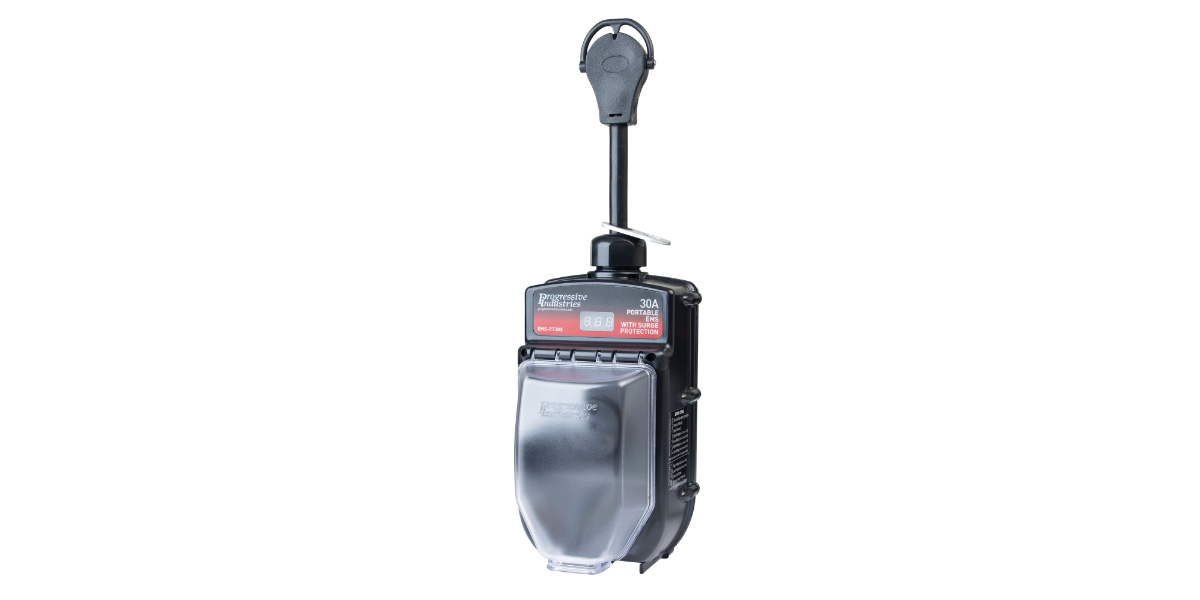
This Progressive Industries portable unit incorporates a display right into the case, making it a simple affair to check status or error codes. Photo Credit: Progressive Industries
Low or High Supply Voltage
We’ve already discussed high voltage with regard to surges and spikes, but voltage that is chronically over the normal 120 volts can also cause problems in your RV. An EMS can detect and prevents the over-voltage from entering your RV.
But by far, the more common problem is under-voltage. We’ve experienced this mainly in older campgrounds as they fill up in the afternoon, and everyone starts turning on their air conditioners.
Low voltage is a serious problem, as it causes your RV and its appliances to pull more current to make up for the low voltage. Power (in watts) is equal to the current (in volts) multiplied by the current (in amps). If the air conditioner operates on 1,500 watts of power, then at a normal 120 volts, it will draw 12.5 amps of current (1,500 = 120 x 12.5). But if the available voltage from the campground were to drop to 100 volts, the air conditioner would need to draw 15 amps of current to get that same 1,500 watts (1,500 = 100 x 15).
So with lower voltage, you’ll be drawing more amperage through the wiring to do the same amount of work. More amperage will increase the heat in the wiring and appliances and will eventually cause damage or tripped breakers.
Most EMS units have a range of voltage that they’ll allow to pass through to your RV. This varies from model to model, but generally low voltage cutoff is somewhere near 104 volts, and high voltage cutoff is somewhere around 132 volts. If the campground power is outside of this range, you’re better off not trying to use it. (And you should notify the campground management about the condition.)
Low or High Line Frequency
The power grid in North America operates at a frequency of 60 hertz (60 cycles per second). Deviations from this standard are rather rare, but if they did happen, an EMS can detect them and isolate your RV from them. You’d be more likely to see this if you plugged the shorepower connection into a generator instead of a grid-connected pedestal.
EMS that protect against this condition will have a range of about 55–65 hertz, where they will allow power to pass through. Power with a frequency outside this range will be isolated from your RV.
Hardwired or Portable?
When you’ve identified which EMS features are most important to you, you’ll still have one more decision to make. Do you want one hardwired into your RV, or would you prefer to have one that is portable that you could plug and unplug as required? All the major manufacturers, including Southwire, Progressive Industries, and Hughes Autoformers, offer both types with similar features, so the choice is really yours.
Portable units are convenient and easy to use. You simply plug one end into the campground pedestal and plug the RV’s shorepower cord into the other end. If you sell your RV, you can take it with you. One advantage of the portable units is that you can choose whether to use them depending on the circumstances. The big disadvantages of the portable units are that they’re bulky to store, and they can be targets for theft.
Hardwired units, on the other hand, are out of sight and out of mind. They’re designed to be permanently wired into your RV in a storage bay. Besides being hidden away from thieves and protected from the weather, you won’t have to worry about storing them, and you can’t forget to hook them up when connecting to shorepower. The downsides of hardwired units are that they’re more difficult to replace and impossible to bypass if you should need to.
The longer you RV, the more likely it is you’ll experience a power delivery problem from a horsepower pedestal. Fortunately, we purchased an EMS early on. We’ve encountered low voltage at several locations. Our EMS has saved us from open-ground connections more than once, and one time it even saved us from a nearby lightning strike. All of these could have turned out much worse without the protection from the EMS, which is why we always travel with one, and I hope you will, too.
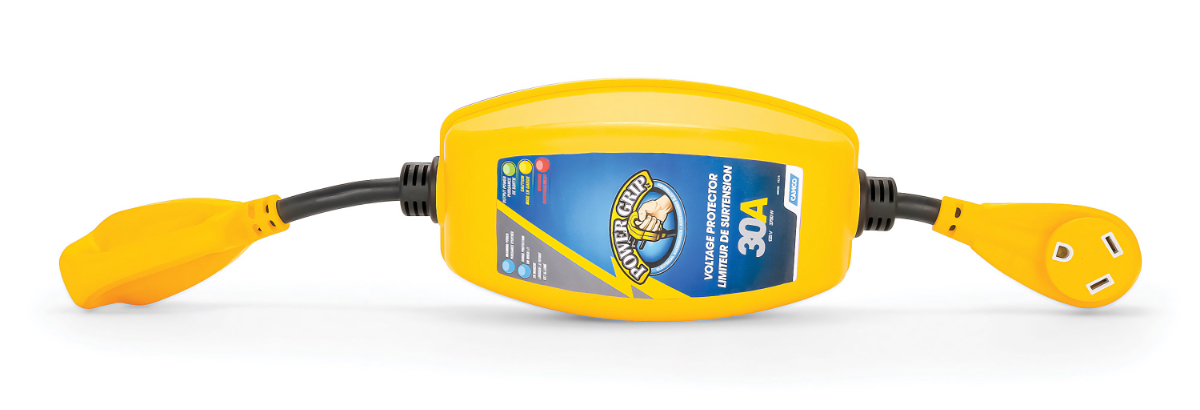
Photo Credit: Camco
An All-Arounder
The Camco Power Grip Voltage Protector series will detect open ground and open neutral conditions at the pedestal. They detect over and under voltage and also offer 2,800 or 4,200 joules of surge suppression in the 30-amp and 50-amp models.
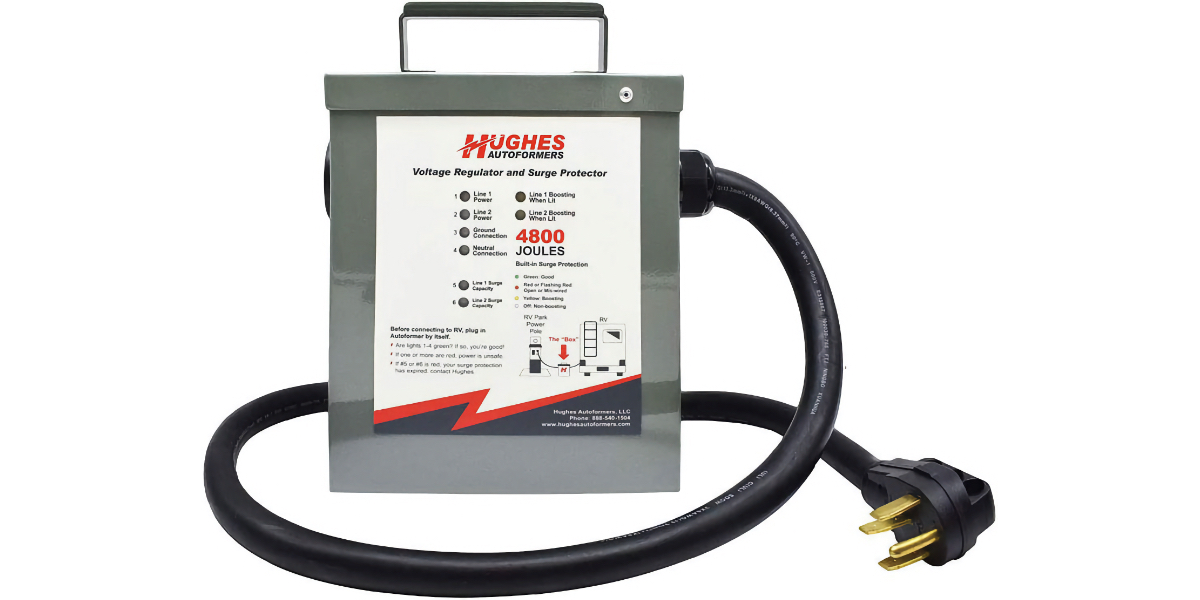
Photo Credit: Hughes Autoformer
A Different Animal
A low-voltage warning from an EMS is not unusual. But what do you do when that happens? Well, first, you should notify park management who—hopefully—can move you to another site that has a better power supply. But sometimes, the entire campground could be affected, and management won’t be able to help. What do you do then? Are you just out of luck?
Not if you have a Hughes Autoformers voltage booster. These devices are capable of boosting the voltage of the incoming power by 10% if the voltage falls below 113 volts. This would effectively turn a low voltage of 109 volts back to a normal 120. But how does it work? Does it steal power from your RV park neighbors?
Well, the answer to that is no. You still plug these devices into the same campground pedestals, which have 30- or 50-amp breakers. They simply can’t draw more power than the 30- or 50-amp breakers will allow. What they do is trade amperage for voltage; essentially, they’ll give a 10% boost in voltage, but the effective maximum amperage will be 10% less.
In a crowded campground on a hot day, with everyone pushing the campground grid to its limit, a device like this could be the difference between your RV’s A/C running or not. I’m not saying everyone needs one of these, but if you find yourself frequently hindered by low campground voltage, it’s something to consider.


